Wicked’s cultural significance cannot be understated. The musical, inspired by Gregory Maguire’s novel of the same name, is Broadway’s 4th longest-running show and has been performed over 8,000 times since its opening night. The movie adaptation has grossed $719.2 million in box office sales and received international recognition due to the estimated $150 million marketing budget that included collaborations with Starbucks, Target, H&M, and more.
The influence of Wicked on pop culture is undeniable, and the costume design of the movie plays a crucial role in that success. Paul Tazewell, the designer for Wicked, having worked for Hamilton, The Wiz, Live!, West Side Story, and Harriet, brings his knowledge in both costume design and history to the movie. His expertise in creating period costumes shows in the fantastical world of Wicked, from the background actors dressed in 1920s evening wear and 1890s cycling suits to Elphaba’s Edwardian-inspired wardrobe. Historical fashion trends can be seen in almost every outfit Glinda and Elphaba wear, blending timeless styles with the characters’ already established images.
Glinda’s “BUBBLE DRESS”
Perhaps the most iconic costume to come out of the film, Glinda’s “bubble dress” is an extravagant Disney-esque ball gown. Inspired by “Dior 1950’s romanticism,” the dress is made of spiraled silk and organza worn over a hoop skirt. Dior, in the years after World War 2,
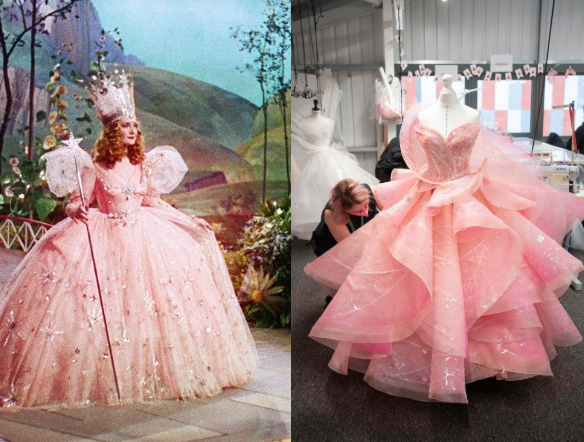
Sources (Left to Right): Harpers Bazaar, Universal Pictures Award
became a fashion powerhouse. After the structured, masculine silhouettes in womens’ fashion were born out of war rationing, many were eager to return to the feminine styles of the pre-war era. This need was perfectly satisfied by Dior’s 1947 “new look,”an ultra-femme, delicate silhouette emphasizing a cinched waist and full skirt that would come to dominate 1950s fashion. Glinda’s dress, with its voluminous skirt, sleeveless bodice, and light pink fabric, would have fit in perfectly with a 1950s Dior catalog.
Tazewell mentions that the dress was additionally inspired by the dress Billie Burke originally wore in the 1939 Wizard of Oz film. It’s not hard to see why. Both dresses feature large, full skirts and, of course, both are pink.
Glinda’s NIGHTGOWN
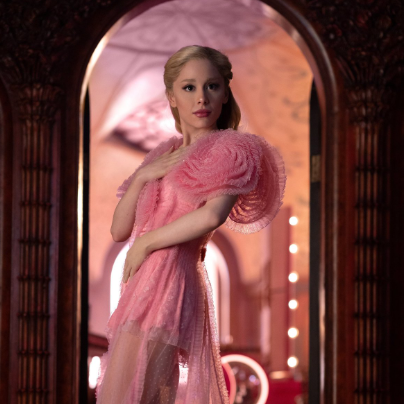
Source: Universal Pictures Awards
If anything screams old Hollywood—it’s Glinda’s nightwear. Tazewell confirms this, stating “Many of [Glinda’s] looks are based on Hollywood icons. Like those 1930s noirs where they wear a lot of teddies.” It’s easy to see this inspiration in the garment, even from just its silhouette. 1930s fashion was defined by a dramatic inverted triangle silhouette with wide shoulders and a defined natural waist—which was quite the change from the boyish silhouette of the 1920s. Skirts often reached mid-calf or all the way to the floor, the latter being especially popular in evening wear. Or, like with Glinda, for nightgowns! This more conservative approach to fashion was influenced by the Great Depression, as well as the popularization of Hollywood stars pioneering fashion trends of the time. Due to the depression, fashion brands had to significantly lower their prices, and began releasing patterns of their dresses so that women could create the same garments at home for a fraction of the price. This led not only to the democratization of fashion but an increase in mass-produced clothes.
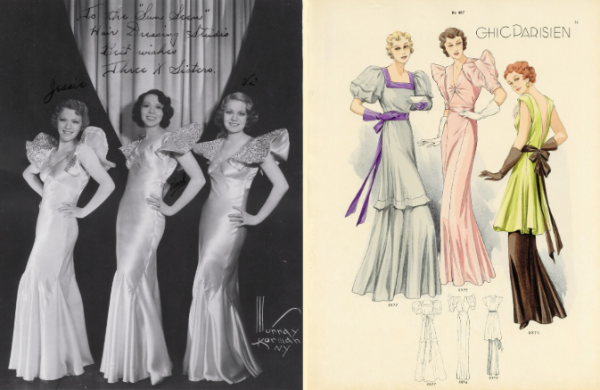
Sources (Left to Right): Wikimedia, Ebay
ELPHABA’S FIRST DAY OF SCHOOL OUTFIT
On the other end of the spectrum, almost all of Elphaba’s fashion incorporates 1890’s and Edwardian silhouettes. In fact, Elphaba’s silhouette is so strongly inspired by the 1890’s that, if not for the skirt length and asymmetrical bodice, it could almost pass off as being from the era.
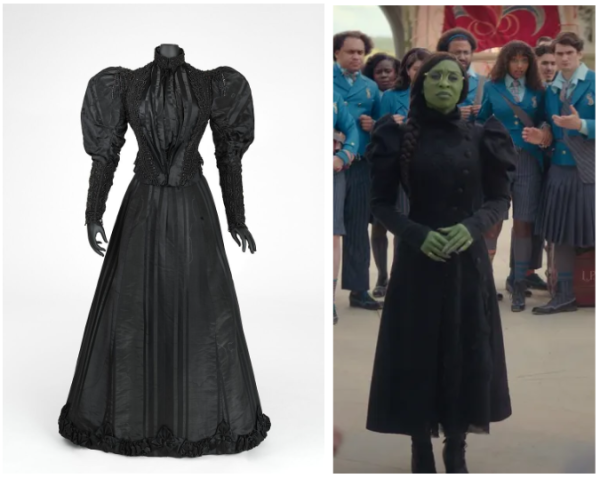
Sources (Left to Right): Flickr, Fashion History
As characters comment on in the movie—the defined shoulders of this dress are one of its most recognizable characteristics. Tazewell really likes his shoulder pads! “Leg of mutton” sleeves were all the rage in the 1890s, reaching their biggest size around 1895 and shrinking into the more conservative Edwardian silhouette by the turn of the century. The sleeve would be held up by a stiff interlining like fibre chamois in order to keep its shape.
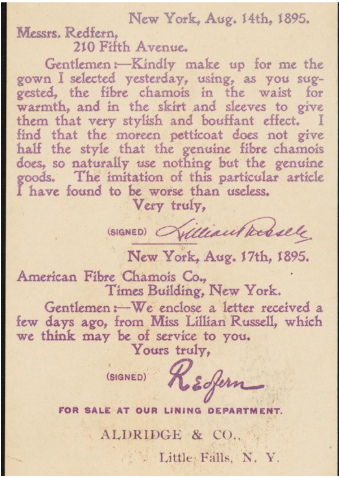
Source: Digital Common Wealth
Another element of the dress that makes it strictly 1890s is the hourglass silhouette. Coming out of the 1880s, defined, small waists were still popular through the 1890s and beyond into the Edwardian era. Usually, this effect was achieved by placing padding around the hips and chest to make the waist look smaller. Contrary to popular belief, tight-lacing was frowned upon even by the Victorians, and was not widely practiced.
ELPHABA’S SCHOOL UNIFORM
Still certainly inspired by 1890s silhouette’s, Elphaba’s uniform leans a little more modern with the skirt falling just below the knees and a separated bodice. As we discussed with Glinda’s uniform, the blazer-skirt combination is a trend seen heavily in 1930s and 1940s fashion. Short skirts were sometimes worn by young girls in the 1890s, but in class photos of the time you will usually still see mostly long ones.
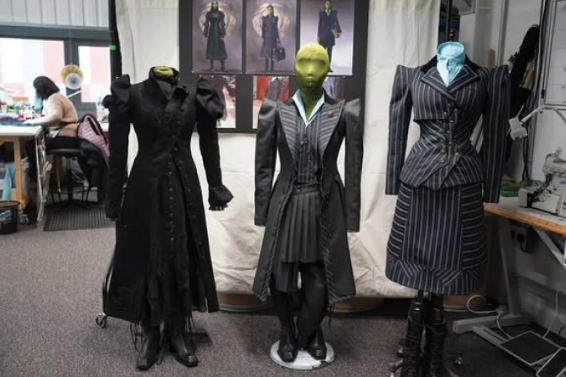
Source: Women’s Wear Daily
However, the hourglass silhouette of the bodice—and the pointed sleeves—still firmly place this outfit in the 1890s, as well as the stripes. The pinstripe fabric, in the 1890’s where it was used mainly for men’s clothing, would be seen as a bold, sporty look. The 1890s saw the introduction of a “new woman” who was more independent and career oriented. Women were bicycling, playing sports, and breaking free of gender roles, and so came the rise of sportswear and more masculine looks, such as cycling suits—and pinstripe fabric!
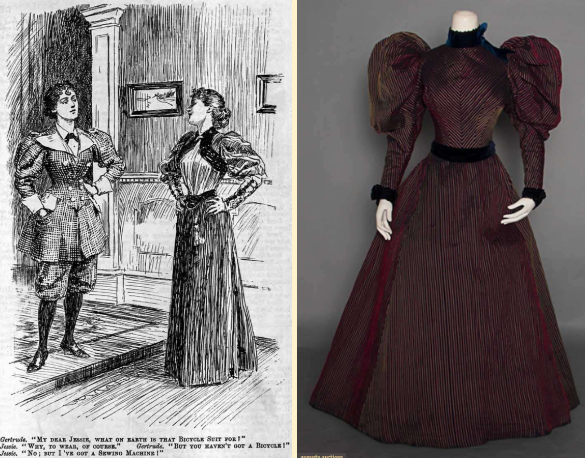
Sources (Left to Right): Wikimedia, Big Augusta Auction
ELPHABA’S OZDUST BALLROOM OUTFIT
Tazewell shifts the silhouette here from 1890’s to Edwardian. The large, defined 1890s sleeves are gone, replaced by a more modest 1900s style “puff” on the shoulder. The most striking feature of this dress, the sheer fabric on the bodice, is reminiscent of the lace front of an Edwardian lingerie dress.
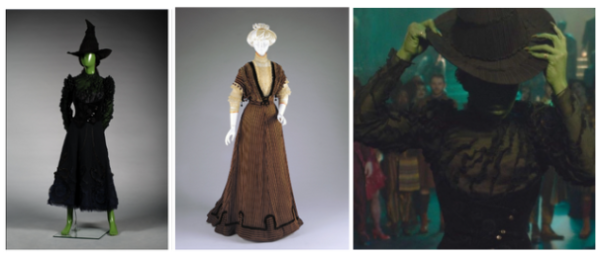
Sources (Left to Right): Forbes, The Dream Stress, Pinterest
The Edwardian era was a less structured continuation of many of the trends popular in the 1890s, with the addition of the new “s-bend” corset. (Though “S-bend” is a modern term and would not have been used in the era.) The new corset, promoted as a healthier version of the 1890s one, pushed the wearer’s hips back and brought the chest forward.

Source: Ancient Faces
The silhouette was further emphasized by a loose shirt tucked into the waistband to create a “pigeon breasted” shape to aid in the illusion of a small waist. Lace became extremely popular in the 1900s, so much so that “lingerie dresses” or light, white summer dresses were almost completely made of lace insertion.
Paul Tazewell’s experience in designing period costumes influenced the inspirations he drew from for the movie—from romantic 1950s Dior and Old Hollywood to the Victorian silhouettes of the 1890s. No matter how fantastical, most costumes are still related to fashion history. These garments not only help define the personalities of the characters but also anchor Wicked firmly in the real world, allowing audiences to connect with the magic of the movie through a familiar visual language rooted in our own history.
